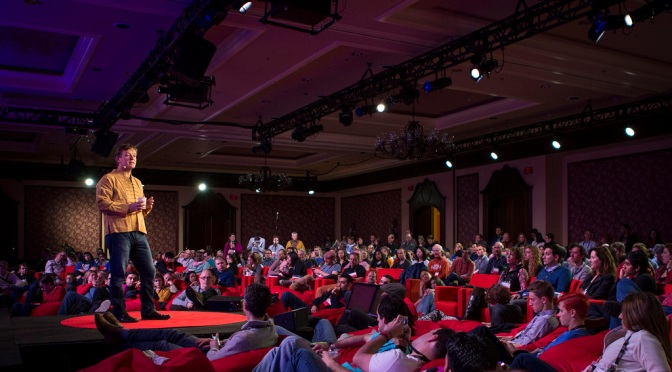By Joe Stephens
It was last Tuesday when David Kwong—magician and crossword puzzle constructor—took the stage at TED. And he put on quite a display. Using a brilliant combination of colored markers, that day’s New York Times crossword, and a random member of the audience, Kwong proudly demonstrated his thesis: “Human beings are wired to solve.”
True as that idea may be, “solutions” to “problems” are not always as neat and tidy as filling in the final letters of a puzzle. And, I would argue, pursuing that level of certainty and closure is very often unsatisfying. This is not to challenge Kwong’s premise, it’s more to limit its application.
You see, there is an answer to 1-Across and 2-Down, but there is only one that is correct. They must fit cleanly together, and when they do, other answers begin to reveal themselves until there are no more questions and no more answers. What if, though, there was a much broader clue to a much bigger puzzle? Something like, “How do you talk about the TED experience?”
Friday afternoon, when the last speaker left the stage, answering that question was the challenge every TED attendee faced. In a span of days, Edward Snowden chatted to us from Russia about the future of global security, Bill and Melinda Gates discussed rural health and philanthropy, Zak Ebrahim made us consider what having a terrorist for a father might feel like, Andrew Solomon put us in the shoes of a gay man without an identity, Ben Saunders took us with him across Antarctica—the list continues, talk after talk.
When you take a selection of the world’s most powerful minds, spread them across a week, and give them a stage to showcase their genius, there might never be the right words to describe what it all adds to. What can you say that completely describes what happened? Most likely nothing. Or, to say it differently, anything you do say will almost certainly wind up incomplete.
The challenge, I think, is to let this be alright. The beauty of emotion, sometimes, is how irreducible it is to language. That’s why people place hands over hearts when they talk about love. It’s why they sometimes shake their head, gaze up, and use their hands when they search for the right way to describe something. Words and answers are not always enough, and when we want them to be—when we want them to have the manicured edges of a crossword puzzle—it is easy to find yourself disappointed.
This is all to say that my hope for us all is singular: let everything that happened last week atomize and rumble around inside energetically and chaotically. Don’t clamor for order where there is none, don’t demand certainty where there can’t be any, and don’t worry about not being sure.
Especially when we are faced with something of a paradox: in this case, where our primal instinct to solve is most likely coupled with our inability to neatly do so. We want to know what TED meant, but we might not know how to express it.
My question, then, is “What if not knowing the answer is perfectly alright?” What if we tell people it was incredible and amazing and awesome and you have to go and I’m so tired and, to some potentially confused looks, get this, I saw Sir Ken Robinson in the airport?
Independently, these are all inadequate. But as they combine—excitedly rushing towards the ears of whoever asked the inevitable, “So, how was it?”—they conjure something quite powerful: you had a week that was actually beyond words. And this is just as it should be.


Regarding the David Kwong TED Talk…I had some thoughts and sent it to him on his FB page…no reply as yet:
TED Talk “whisper”…
Hi David. Correct me if I’m wrong – but this trick would have been much more impressive had the lady chosen by herself which animal to color in with what color…but you told her which animal to color in with her chosen color – thus, I suspect, someone “whispered” the color she chose in your ear (very visible microphone/earpiece worn), and you then just directed her to color in that animal to fall in with the rest of your trick. All the other smoke and mirrors (newspaper crossword; images on screen in same colors etc.) would have been super easy to prepare and use to create “chaos”, leaving the audience to think something cool happened when in fact, you just made sure she colored the animals to slot in with your “reveal”. Maybe I’m wrong and something cool actually happened. Stay cool. Frans.
LikeLike